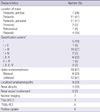1. Ormond JK. Bilateral ureteral obstruction due to envelopment and compression by an inflammatory retroperitoneal process. J Urol. 1948. 59:1072–1079.
2. Vaglio A, Salvarani C, Buzio C. Retroperitoneal fibrosis. Lancet. 2006. 367:241–251.
3. Vaglio A, Palmisano A, Corradi D, Salvarani C, Buzio C. Retroperitoneal fibrosis: evolving concepts. Rheum Dis Clin North Am. 2007. 33:803–817.
4. Martorana D, Vaglio A, Greco P, Zanetti A, Moroni G, Salvarani C, Savi M, Buzio C, Neri TM. Chronic periaortitis and HLA-DRB1*03: another clue to an autoimmune origin. Arthritis Rheum. 2006. 55:126–130.
5. Uibu T, Oksa P, Auvinen A, Honkanen E, Metsärinne K, Saha H, Uitti J, Roto P. Asbestos exposure as a risk factor for retroperitoneal fibrosis. Lancet. 2004. 363:1422–1426.
6. Hamano H, Kawa S, Ochi Y, Unno H, Shiba N, Wajiki M, Nakazawa K, Shimojo H, Kiyosawa K. Hydronephrosis associated with retroperitoneal fibrosis and sclerosing pancreatitis. Lancet. 2002. 359:1403–1404.
7. Mitchinson MJ. Chronic periaortitis and periarteritis. Histopathology. 1984. 8:589–600.
8. Vaglio A, Corradi D, Manenti L, Ferretti S, Garini G, Buzio C. Evidence of autoimmunity in chronic periaortitis: a prospective study. Am J Med. 2003. 114:454–462.
9. Magrey MN, Husni ME, Kushner I, Calabrese LH. Do acute-phase reactants predict response to glucocorticoid therapy in retroperitoneal fibrosis? Arthritis Rheum. 2009. 61:674–679.
10. Bani-Hani KE, Bani-Hani IH, Al-Heiss HA, Omari HZ. Retroperitoneal fibrosis. Demographic, clinical and pathological findings. Saudi Med J. 2002. 23:711–715.
11. Li KP, Zhu J, Zhang JL, Huang F. Idiopathic retroperitoneal fibrosis (RPF): clinical features of 61 cases and literature review. Clin Rheumatol. 2011. 30:601–605.
12. Lee JE, Han SH, Kim DK, Moon SJ, Choi KH, Lee HY, Han DS, Cho NH, Oh YT, Kim BS. Idiopathic retroperitoneal fibrosis associated with Hashimoto's thyroiditis in an old-aged man. Yonsei Med J. 2008. 49:1032–1035.
13. Vaglio A. Retroperitoneal fibrosis: new insights into clinical presentation and diagnosis. Medicine (Baltimore). 2009. 88:208–210.
14. Scheel PJ Jr, Feeley N. Retroperitoneal fibrosis: the clinical, laboratory, and radiographic presentation. Medicine (Baltimore). 2009. 88:202–207.
15. van Bommel EF. Retroperitoneal fibrosis. Neth J Med. 2002. 60:231–242.
16. Baker LR, Mallinson WJ, Gregory MC, Menzies EA, Cattell WR, Whitfield HN, Hendry WF, Wickham JE, Joekes AM. Idiopathic retroperitoneal fibrosis. A retrospective analysis of 60 cases. Br J Urol. 1987. 60:497–503.
17. van Bommel EF, Jansen I, Hendriksz TR, Aarnoudse AL. Idiopathic retroperitoneal fibrosis: prospective evaluation of incidence and clinicoradiologic presentation. Medicine (Baltimore). 2009. 88:193–201.
18. Koep L, Zuidema GD. The clinical significance of retroperitoneal fibrosis. Surgery. 1977. 81:250–257.
19. Jois RN, Gaffney K, Marshall T, Scott DG. Chronic periaortitis. Rheumatology (Oxford). 2004. 43:1441–1446.
20. Cottin V, Brillet PY, Combarnous F, Duperron F, Nunes H, Cordier JF. Syndrome of pleural and retrosternal "bridging" fibrosis and retroperitoneal fibrosis in patients with asbestos exposure. Thorax. 2008. 63:177–179.
21. Warnatz K, Keskin AG, Uhl M, Scholz C, Katzenwadel A, Vaith P, Peter HH, Walker UA. Immunosuppressive treatment of chronic periaortitis: a retrospective study of 20 patients with chronic periaortitis and a review of the literature. Ann Rheum Dis. 2005. 64:828–833.
22. Vaglio A, Greco P, Corradi D, Palmisano A, Martorana D, Ronda N, Buzio C. Autoimmune aspects of chronic periaortitis. Autoimmun Rev. 2006. 5:458–464.
23. van Bommel EF, Siemes C, Hak LE, van der Veer SJ, Hendriksz TR. Long-term renal and patient outcome in idiopathic retroperitoneal fibrosis treated with prednisone. Am J Kidney Dis. 2007. 49:615–625.
24. Vaglio A, Palmisano A, Ferretti S, Alberici F, Casazza I, Salvarani C, Buzio C. Peripheral inflammatory arthritis in patients with chronic periaortitis: report of five cases and review of the literature. Rheumatology (Oxford). 2008. 47:315–318.
25. Nabi HA, Zubeldia JM. Clinical applications of (18)F-FDG in oncology. J Nucl Med Technol. 2002. 30:3–9.
26. Ishimori T, Saga T, Mamede M, Kobayashi H, Higashi T, Nakamoto Y, Sato N, Konishi J. Increased (18)F-FDG uptake in a model of inflammation: concanavalin A-mediated lymphocyte activation. J Nucl Med. 2002. 43:658–663.
27. Vaglio A, Versari A, Fraternali A, Ferrozzi F, Salvarani C, Buzio C. (18)F-fluorodeoxyglucose positron emission tomography in the diagnosis and followup of idiopathic retroperitoneal fibrosis. Arthritis Rheum. 2005. 53:122–125.
28. Jansen I, Hendriksz TR, Han SH, Huiskes AW, van Bommel EF. (18)F-fluorodeoxyglucose position emission tomography (FDG-PET) for monitoring disease activity and treatment response in idiopathic retroperitoneal fibrosis. Eur J Intern Med. 2010. 21:216–221.
29. Fry AC, Singh S, Gunda SS, Boustead GB, Hanbury DC, McNicholas TA, Farrington K. Successful use of steroids and ureteric stents in 24 patients with idiopathic retroperitoneal fibrosis: a retrospective study. Nephron Clin Pract. 2008. 108:c213–c220.
30. Kamisawa T, Okamoto A. IgG4-related sclerosing disease. World J Gastroenterol. 2008. 14:3948–3955.





 PDF
PDF ePub
ePub Citation
Citation Print
Print







 XML Download
XML Download